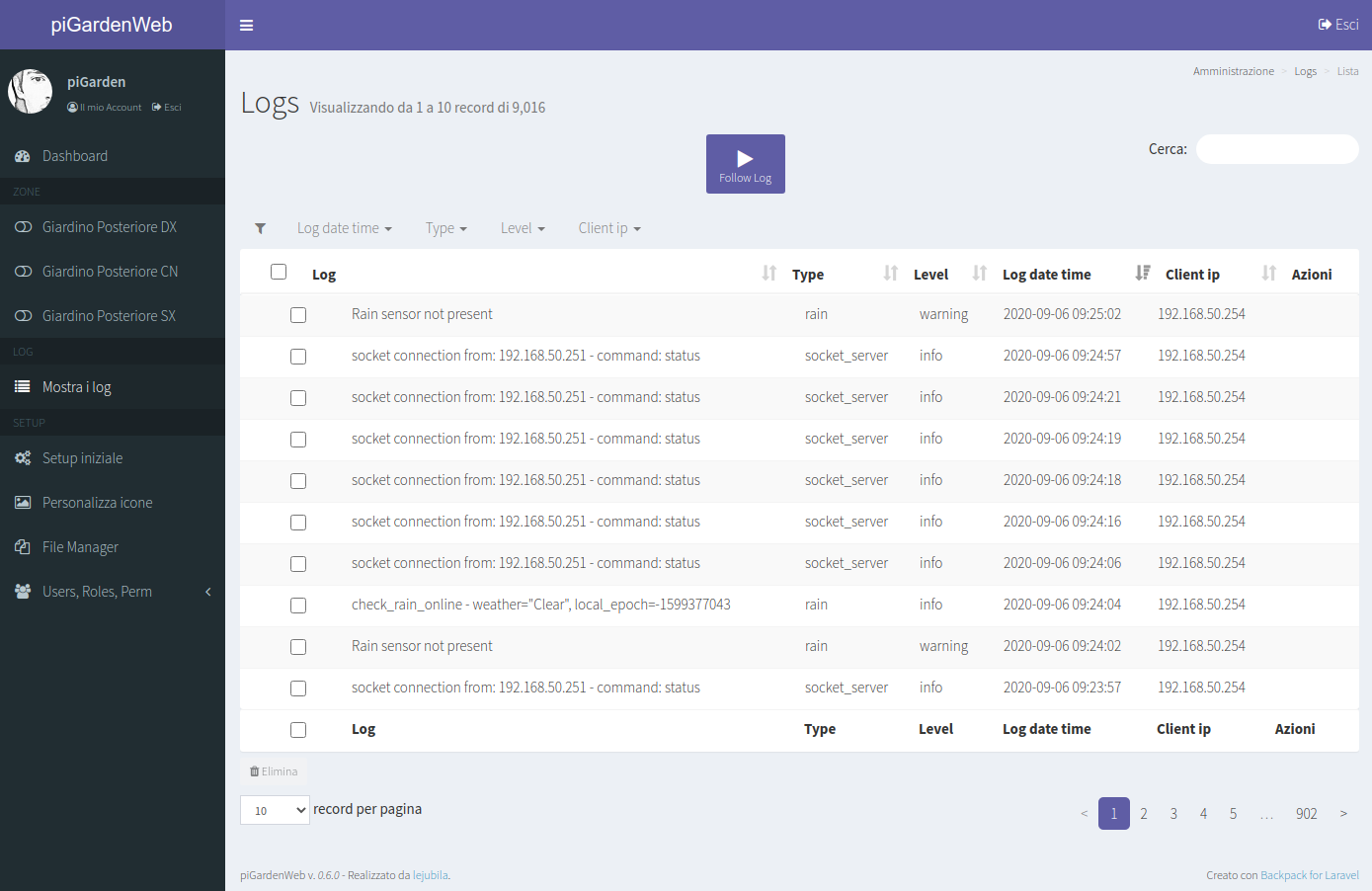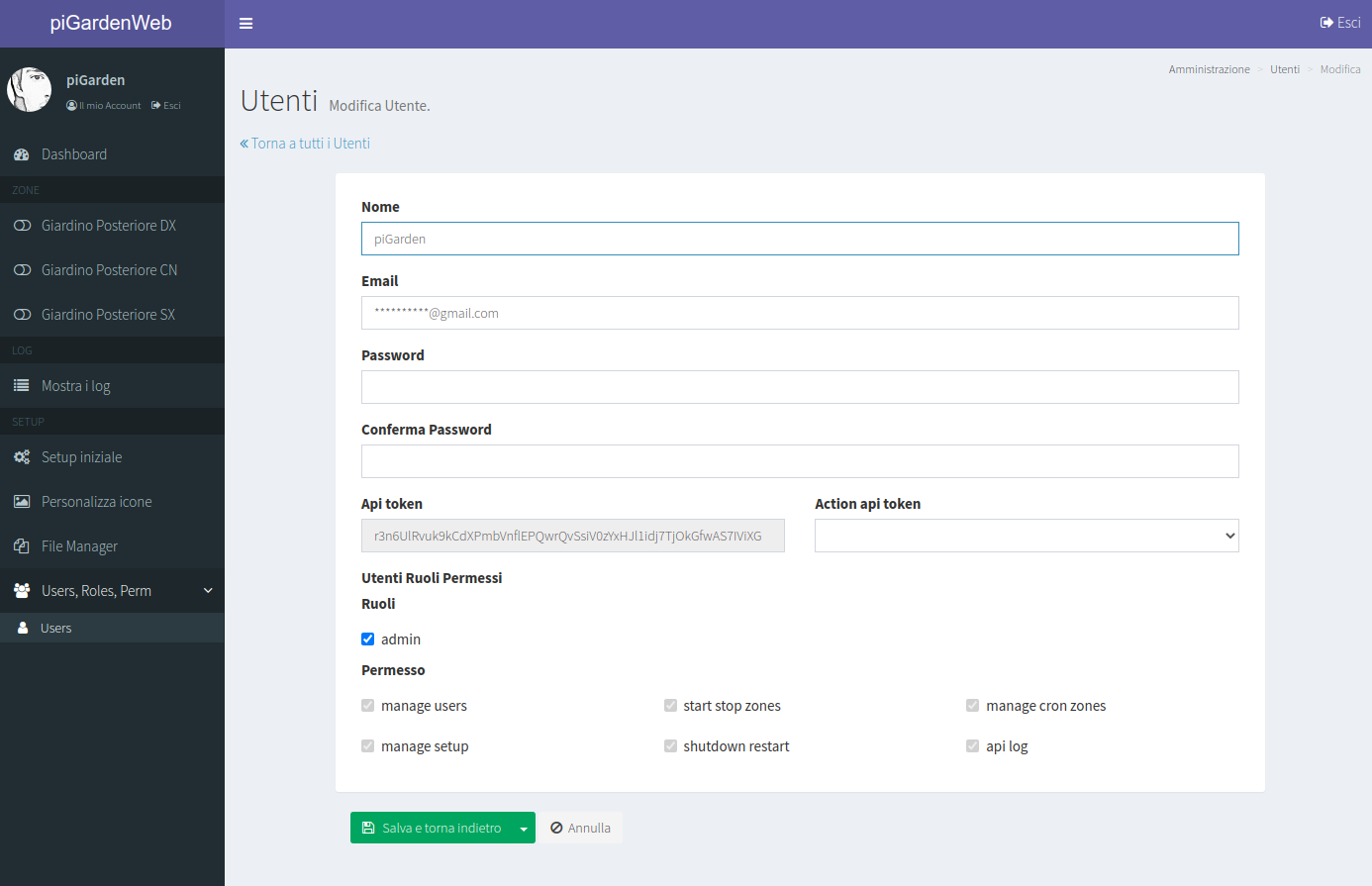Web control panel to manage your piGarden (system irrigation with Raspberry Pi)
Documentation of piGarden and build system irrigation with Raspberry Pi can be found on the www.lejubila.net/tag/pigarden/
This script is open-sourced software under GNU General Public License v3.0
PiGardenWeb is an web application based on Laravel, Backpack and piGarden. To work on your Rasperry Pi, it needs php 7.1.3, nginx web server and other packages.
-
Installs the necessary packages on your terminal:
sudo apt install nginx php-fpm php-cli php-mcrypt php-sqlite3 git
-
Configure php: modify the file /etc/php/7.3/fpm/php.ini, search and uncomment the line with cgi.fix_pathinfo and assigned the value zero:
cgi.fix_pathinfo=0
-
Enable php modules:
sudo phpenmod sqlite3
-
Download piGardenWeb in your home:
cd git clone https://github.com/lejubila/piGardenWeb.git -
Configure nginx with the configuration file present in piGardenWeb and personalize it if necessary:
cd sudo cp /etc/nginx/sites-available/default /etc/nginx/sites-available/default.original sudo cp piGardenWeb/virtualhost/nginx/default-php7.3 /etc/nginx/sites-available/default -
Configure piGardenWeb
-
Create configuration file .env
cd cd piGardenWeb cp .env.example .env
-
Create sqlite and initialize database, generate application key, assign owner and permission
touch database/piGarden.sqlite php7.3 artisan key:generate php7.3 artisan migrate php7.3 artisan db:seed sudo chown -R pi:www-data /home/pi/piGardenWeb/ sudo chmod -R g+w storage database database/piGarden.sqlite
-
Modify .env to your liking
-
-
Start nginx web server
sudo systemctl restart nginx
-
Install piGarden script and start socket_server (skip this point if you have already installed the pigarden on your Raspberry Pi):
- Download and install piGarden script in your home, see github.com/lejubila/piGarden
- Start piGarden socket server
cd cd piGarden ./piGarden start_socket_server force
-
Remove piGarden crontab scheduling if already present (skip this point if you have NOT already installed the pigarden on your raspberry pi)
-
Open your browser on http://ip_address_of_your_raspberry_pi and register your user.
-
Sign in to piGardenWeb with the newly created user
-
Goto in to menu "Users, Roles, Perm / Users" and assign admin role to your user
-
Perform the initial setup from the menu "SETUP / Initial setup"
-
Now you can disable open registration by editing the .env file and setting REGISTRATION_OPEN with the value "false". Also disable ALLOW_MANAGE_USER and ALLOW_MANAGE_ROLE_AND_PERMISSION. You can also change the language of the interface (LOCALE = en / it) and smtp parameters for sending email notifications to reset the user password.
PiGardenWeb is an web application based on Laravel, Backpack and piGarden. To work on your Rasperry Pi, it needs php 5.5.9, nginx web server and other packages.
-
Installs the necessary packages on your terminal:
sudo apt install nginx php-fpm php-cli php-mcrypt php-sqlite3 git
-
Configure php: modify the file /etc/php/7.0/fpm/php.ini, search and uncomment the line with cgi.fix_pathinfo and assigned the value zero:
cgi.fix_pathinfo=0
-
Enable php modules:
sudo phpenmod mcrypt sudo phpenmod sqlite3
-
Download piGardenWeb in your home:
cd git clone https://github.com/lejubila/piGardenWeb.git -
Configure nginx with the configuration file present in piGardenWeb and personalize it if necessary:
cd sudo cp /etc/nginx/sites-available/default /etc/nginx/sites-available/default.original sudo cp piGardenWeb/virtualhost/nginx/default-php7 /etc/nginx/sites-available/default -
Configure piGardenWeb
-
Create configuration file .env
cd cd piGardenWeb cp .env.example .env
-
Create sqlite and initialize database, generate application key, assign owner and permission
touch database/piGarden.sqlite ./artisan key:generate ./artisan migrate sudo chown -R pi:www-data /home/pi/piGardenWeb/ sudo chmod -R g+w storage database database/piGarden.sqlite
-
Modify .env to your liking
-
-
Start nginx web server
sudo systemctl restart nginx
-
Install piGarden script and start socket_server (skip this point if you have already installed the pigarden on your Raspberry Pi):
- Download and install piGarden script in your home, see github.com/lejubila/piGarden
- Start piGarden socket server
cd cd piGarden ./piGarden start_socket_server force
-
Remove piGarden crontab scheduling if already present (skip this point if you have NOT already installed the pigarden on your raspberry pi)
-
Open your browser on http://ip_address_of_your_raspberry_pi and register your user.
-
Sign in to piGardenWeb with the newly created user, and perform the initial setup from the menu "SETUP / Initial setup"
-
Now you can disable open registration by editing the .env file and setting REGISTRATION_OPEN with the value "false". You can also change the language of the interface (LOCALE = en / it) and smtp parameters for sending email notifications to reset the user password.
PiGardenWeb is an web application based on Laravel, Backpack and piGarden. To work on your Rasperry Pi, it needs php 5.5.9, nginx web server and other packages.
-
Installs the necessary packages on your terminal:
sudo apt-get install nginx php5-fpm php5-cli php5-mcrypt php5-sqlite git
-
Configure php: modify the file /etc/php5/fpm/php.ini, search and uncomment the line with cgi.fix_pathinfo and assigned the value zero:
cgi.fix_pathinfo=0
-
Enable php modules:
sudo php5enmod mcrypt sudo php5enmod sqlite3
-
Download piGardenWeb in your home:
cd git clone https://github.com/lejubila/piGardenWeb.git -
Configure nginx with the configuration file present in piGardenWeb and personalize it if necessary:
cd sudo cp /etc/nginx/sites-available/default /etc/nginx/sites-available/default.original sudo cp piGardenWeb/virtualhost/nginx/default /etc/nginx/sites-available/default -
Configure piGardenWeb
-
Create configuration file .env
cd cd piGardenWeb cp .env.example .env
-
Create sqlite and initialize database, generate application key, assign owner and permission
touch database/piGarden.sqlite ./artisan key:generate ./artisan migrate sudo chown -R pi:www-data /home/pi/piGardenWeb/ sudo chmod -R g+w storage database database/piGarden.sqlite
-
Modify .env to your liking
-
-
Start nginx web server
sudo service nginx restart
-
Install piGarden script and start socket_server (skip this point if you have already installed the pigarden on your Raspberry Pi):
- Download and install piGarden script in your home, see github.com/lejubila/piGarden
- Start piGarden socket server
cd cd piGarden ./piGarden.sh start_socket_server force
-
Remove piGarden crontab scheduling if already present (skip this point if you have NOT already installed the pigarden on your raspberry pi)
-
Open your browser on http://ip_address_of_your_raspberry_pi and register your user.
-
Sign in to piGardenWeb with the newly created user, and perform the initial setup from the menu "SETUP / Initial setup"
-
Now you can disable open registration by editing the .env file and setting REGISTRATION_OPEN with the value "false". You can also change the language of the interface (LOCALE = en / it) and smtp parameters for sending email notifications to reset the user password.



